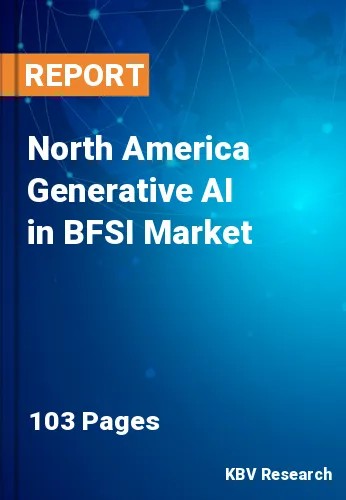Chapter 1. Market Scope & Methodology
1.1 Market Definition
1.2 Objectives
1.3 Market Scope
1.4 Segmentation
1.4.1 North America Generative AI in BFSI Market, by End-User
1.4.2 North America Generative AI in BFSI Market, by Application
1.4.3 North America Generative AI in BFSI Market, by Country
1.5 Methodology for the research
Chapter 2. Market at a Glance
2.1 Key Highlights
Chapter 3. Market Overview
3.1 Introduction
3.1.1 Overview
3.1.1.1 Market Composition and Scenario
3.2 Key Factors Impacting the Market
3.2.1 Market Drivers
3.2.2 Market Restraints
3.2.3 Market Opportunities
3.2.4 Market Challenges
Chapter 4. Competition Analysis – Global
4.1 Market Share Analysis, 2023
4.2 Strategies Deployed in Generative AI in BFSI Market
4.3 Porter Five Forces Analysis
Chapter 5. North America Generative AI in BFSI Market by End-User
5.1 North America Banks Market by Country
5.2 North America Insurance Companies Market by Country
5.3 North America Financial Service Providers Market by Country
Chapter 6. North America Generative AI in BFSI Market by Application
6.1 North America Fraud Detection Market by Country
6.2 North America Risk Assessment Market by Country
6.3 North America Customer Experience Market by Country
6.4 North America Algorithmic Trading Market by Country
6.5 North America Other Application Market by Country
Chapter 7. North America Generative AI in BFSI Market by Country
7.1 US Generative AI in BFSI Market
7.1.1 US Generative AI in BFSI Market by End-User
7.1.2 US Generative AI in BFSI Market by Application
7.2 Canada Generative AI in BFSI Market
7.2.1 Canada Generative AI in BFSI Market by End-User
7.2.2 Canada Generative AI in BFSI Market by Application
7.3 Mexico Generative AI in BFSI Market
7.3.1 Mexico Generative AI in BFSI Market by End-User
7.3.2 Mexico Generative AI in BFSI Market by Application
7.4 Rest of North America Generative AI in BFSI Market
7.4.1 Rest of North America Generative AI in BFSI Market by End-User
7.4.2 Rest of North America Generative AI in BFSI Market by Application
Chapter 8. Company Profiles
8.1 Accenture PLC
8.1.1 Company Overview
8.1.2 Financial Analysis
8.1.3 Segmental Analysis
8.1.4 Research & Development Expenses
8.1.5 Recent strategies and developments:
8.1.5.1 Partnerships, Collaborations, and Agreements:
8.1.6 SWOT Analysis
8.2 SAS Institute, Inc.
8.2.1 Company Overview
8.2.2 SWOT Analysis
8.3 Google LLC (Alphabet Inc.)
8.3.1 Company Overview
8.3.2 Financial Analysis
8.3.3 Segmental and Regional Analysis
8.3.4 Research & Development Expense
8.3.5 Recent strategies and developments:
8.3.5.1 Partnerships, Collaborations, and Agreements:
8.3.6 SWOT Analysis
8.4 Salesforce, Inc.
8.4.1 Company Overview
8.4.2 Financial Analysis
8.4.3 Regional Analysis
8.4.4 Research & Development Expenses
8.4.5 SWOT Analysis
8.5 Microsoft Corporation
8.5.1 Company Overview
8.5.2 Financial Analysis
8.5.3 Segmental and Regional Analysis
8.5.4 Research & Development Expenses
8.5.5 Recent strategies and developments:
8.5.5.1 Product Launches and Product Expansions:
8.5.6 SWOT Analysis
8.6 Adobe, Inc.
8.6.1 Company Overview
8.6.2 Financial Analysis
8.6.3 Segmental and Regional Analysis
8.6.4 Research & Development Expense
8.6.5 SWOT Analysis
8.7 OpenAI, L.L.C.
8.7.1 Company Overview
8.7.2 SWOT Analysis
8.8 IBM Corporation
8.8.1 Company Overview
8.8.2 Financial Analysis
8.8.3 Regional & Segmental Analysis
8.8.4 Research & Development Expenses
8.8.5 SWOT Analysis
8.9 NVIDIA Corporation
8.9.1 Company Overview
8.9.2 Financial Analysis
8.9.3 Segmental and Regional Analysis
8.9.4 Research & Development Expenses
8.9.5 SWOT Analysis
8.10. Intel Corporation
8.10.1 Company Overview
8.10.2 Financial Analysis
8.10.3 Segmental and Regional Analysis
8.10.4 Research & Development Expenses
8.10.5 SWOT Analysis

